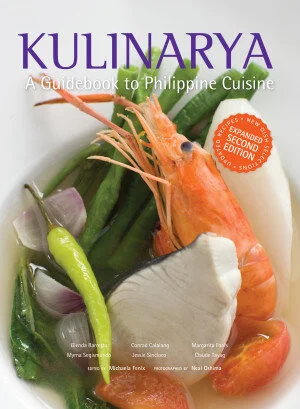The Happy Home Cook: Tinolang Manok (Chicken Soup)
/The Happy Home Cook features cherished recipes of Filipino dishes from well-known foodies and contributors. If you have a recipe that you are proud of and would like to share, please send it along with a photo of the dish, your two-sentence bio and your picture to submissions@positivelyfilipino.com.
Tinolang Manok (Source: Kulinarya: A Guidebook to Philippine Cuisine, Expanded Second Edition (Anvil Publishing Inc., 2013))
Serves 6
Ingredients
1 thumb-sized piece (25 g) ginger
2 cloves (10 g) garlic
½ (40 g) onion
½ (250 g) green papaya
2 tbsp (30 ml) cooking oil
1 (500 g) chicken breast, bone-in
2 tbsp (30 ml) fish sauce (patis)
10 cups (2 ½ liters) water or chicken broth
2 tsp (10 g) salt
15 g chili leaves
6 green solo papayas (optional, see Tips)
Preparation
1. Peel and cut the ginger crosswise into thin slices.
2. Crush, peel and mince the garlic.
3. Peel and chop the onion finely.
4. Peel the green papaya and cut evenly into wedges.
Cooking
1. In a preheated pan, saute ginger, garlic and the onion in cooking oil.
2. Add the chicken breast.
3. Season with fish sauce. Add the chicken broth and boil. Reduce heat and simmer until chicken is cooked.
4. Remove the chicken breast and cool. Debone. Carefully cut meat into 2.5 cm (1-inch) cubes. Set aside.
5. Strain the broth and return to the pot.
6. Just before serving, bring the broth to boil again. Add the papaya wedges and cook until tender. Add the chicken. Adjust the seasoning.
7. Lastly, add chili leaves.
Serving Suggestion
Serve piping hot in individual soup bowls or in solo papaya bowls with a cover. Accompany with fish sauce mixed with calamansi.
Tips
Chicken can be either deboned breast or thighs cut into 1-in cubes. Make sure your guests get choice cuts.
The tinola can be presented in a small green papaya. Cut the top of the papaya to allow a cavity for the soup. Remove the seeds, replace the other half, then blanch the whole papaya until tender, but not soggy. The blanched papaya should be hot when filling it with the soup. A well-chosen papaya, even when green, will add sweetness to the broth. Soaking the green papaya in rock salt takes away the bitterness.
Leafy vegetables should always be blanched then added just before serving.
In many provinces, the native free range chicken is used. It takes more time to make the meat tender but the dish is more flavorful.
Instead of chili leaves, the leaves of the horseradish tree (malunggay) can be substituted. The horseradish tree grows easily in backyards and its leaves are used in many soups. Malunggay leaves are traditionally believed to help lactating mothers produce more milk, and there is some evidence for this in medical science. The malunggay pods can also be cooked in broth.
From Kulinarya: A Guidebook to Philippine Cuisine, Expanded Second Edition.



